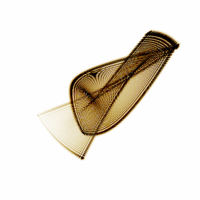This visual continues the exploration started here. I used the dataset of MathSciNet records of the publications by department members, collected by the IGL participants. Each article reviewed by MSN carries a few MSC codes, roughly classifying them. I used these codes to create a sankey diagram, showing who published in what area.
A few remarks:
- The widths of the links are \(c+\sqrt{n}\), where \(c\) is some constant, and \(n\) is the number of the articles in the given area by the corresponding faculty member… This somewhat idiosyncratic choice was to make sure both the diversity of the output, and its volume were reflected, without some overwhelming visual disparity.
- I used just the top level subjects (already overpopulated).
- To use the chart, hover your cursor over the area: the tentacles will spread towards all the faculty who published there. Alternatively, picking a faculty member, you’ll see where their output is. (This uses the amazing Chart Studio‘s API.)
- The idea is that this chart gives a somewhat better understanding where the current department’s strengths are. (The commonly used approach, where a department’s web boss creates a list of areas, and then populates it with lists of faculty is cumbersome and slow.)
- The biggest problem with the chart is the MSC: the wildly different in scale and granularity boxes are updated rarely, and often don’t reflect the reality on the ground. MathSciNet is one of the most useful services provided by the AMS to the community. It would make sense to invest a bit into maintaining its infrastructure, and to use some more dynamic approach to the discipline’s taxonomies.
- Unfortunately, some of the department members are not included (first and foremost, postdocs), – we are planning to make this diagram more comprehensive, and update it regularly.
An interesting byproduct of the process are two linear orderings, – one of the MSCs and the other of the faculty members. They were produced automatically: my understanding is that the software does a few rounds of reorderings on either side, to reduce the total crossings (in effect realizing a version of the singular value decomposition for the matrix with the entries described above).
The algorithm is fed these numbers and is completely oblivious to the semantics of the MSC codes or the faculty research area memberships. Nonetheless, the orders make sense.
One can see up-down progression from more algebraic to more analytic areas on the right, with geometry and topology wedged in somewhere in the middle.
Similarly, one can make a pretty plausible partition of the department into research areas by cutting the emerged list, without much shuffling.
Not bad, for a silly visualization routine…
